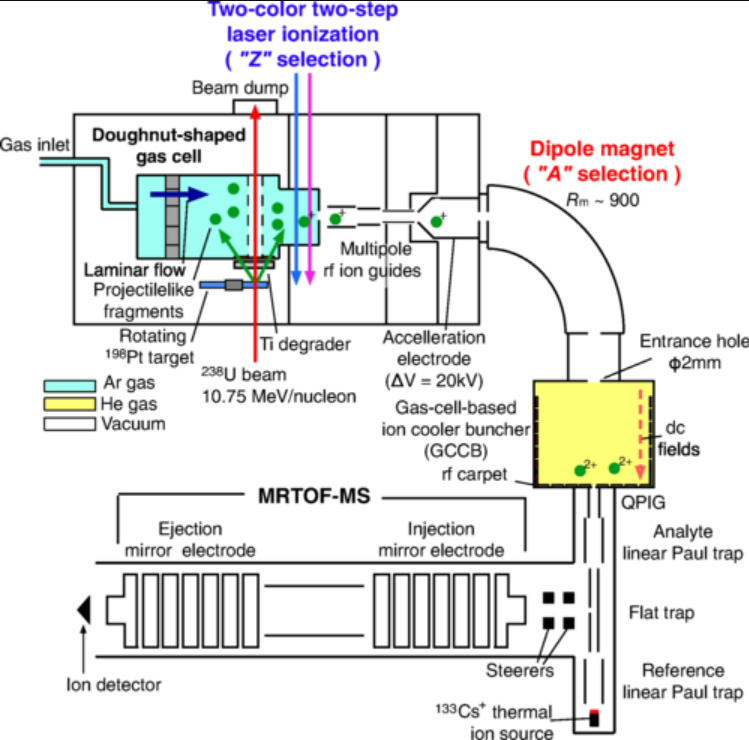Science
Related: About this forumSometimes You Need KISS: The creation of 241U.
I stumbled across this one while looking for something else:
Discovery of New Isotope 241U and Systematic High-Precision Atomic Mass Measurements of Neutron-Rich Pa-Pu Nuclei Produced via Multinucleon Transfer Reactions T. Niwase, Y.?X. Watanabe, Y. Hirayama, M. Mukai, P. Schury, A.?N. Andreyev, T. Hashimoto, S. Iimura, H. Ishiyama, Y. Ito, S.?C. Jeong, D. Kaji, S. Kimura, H. Miyatake, K. Morimoto, J.-Y. Moon, M. Oyaizu, M. Rosenbusch, A. Taniguchi, and M. Wada Phys. Rev. Lett. 130, 132502
Some text:
The stability or existence of an isotope depends on its binding energy, which in the simplest approximation, can be expressed as the sum of a bulk macroscopic part (the “liquid-drop contribution”) and a microscopic shell correction energy. In most nuclides, especially in the light region, the former contribution is dominant, but the shell corrections can play a substantial role and often result in dramatic nuclear structure changes, as documented in many cases across the chart of nuclei [9,10].
On the contrary, in the region of high atomic number ( Z≳100), the strong Coulomb repulsion between protons makes the macroscopic contribution relatively small such that it alone cannot bind superheavy nuclides (SHN) [3,11]. Because of this, the mere existence of SHN is defined by a shell correction energy which is manifested in the creation of nucleonic subshell closures of spherical or deformed nature, enhancing the stability of a nucleus [12,13]. For example, in the actinide and transactinide regions, the deformed subshell closures at Z=108 and N=162, and Z=100?102 and N=152 have long been predicted [14–17]. Figure 1 shows a plot of the ground state shell correction energy as calculated by a macroscopic-microscopic model (FRDM12 [18]) for the 90Th-102No nuclides around N=152. An island of strong shell corrections with values as low as about ?5??MeV is centered around 100Fm-102No. Indeed, evidence of the deformed shell closure at N=152 was first established as early as the 1950s [19,20] and its nature has since been experimentally confirmed by various methods, e.g., through observation of rotational bands and high-spin K isomers [21,22], and measurements of masses [23] and spontaneous fission half-lives [24]. A primary reason for the richness of experimental data in this area is its accessibility via fusion reactions between partners close to doubly magic 20882Pb and 4820Ca, which result in enhanced production cross sections [25]...
Sometimes you need KISS:
An overview of the KISS experimental setup is shown in Fig. 2. A primary beam of 23892U [ 10.75??MeV/nucleon, typical intensity of ?30 particle nA (1 particle nA is 6.2×109??particles/s)], accelerated by the RIKEN Ring Cyclotron, impinged for four days upon a rotating 19878Pt (enriched to 91.63%) target [37] with a thickness of 12.5??mg/cm2. The isotopes of interest were produced as PLFs in the MNT reactions, having masses and velocities close to those of the primary beam particles, and being scattered around the grazing angle. The energy of these reaction products was attenuated by a 40-?m Ti energy degrader to maximize the fraction stopping in a doughnut-shaped gas cell [37] filled with 65-kPa argon gas...
KISS:

The caption:
Sketch of the KISS experimental setup. The blue- and yellow-colored areas are filled with Ar and He gases, respectively. Differential pumping systems are located after the doughnut-shaped gas cell as well as before and after the GCCB.
Like John Lennon said...
"I just had to look..."
Cheezoholic
(2,862 posts)MutantAndProud
(855 posts)The refinement in atomic physics increase year after year and never lose fascination at the new depths of precise clarity one level ‘below’ the next on the particle field development chronologies and interaction vectors
NNadir
(35,545 posts)It goes, of course, far beyond particle physics.
I'm definitely not living in the world into which I was born; I'm not living in the world in which I was living when when I turned 30.
Every time I go to any kind of scientific conference, my mind is blown.
eppur_se_muova
(38,815 posts)I had thought the shell effects referred to in the 2nd para of the excerpt had been somewhat overemphasized in many discussions, but apparently the opposite is true, as the third para makes clear. Bookmarking this paper; looks like a gold mine of references.
Interesting to see how much post-collision processing is going on here. I had been wondering about the practicality of such things, but in the context of the more usual nuclear fusion reactions.
(When I first saw KISS in all caps I thought it was a reference to the rock group ... but then I realized it was the old sci/eng saw. Also noticed my own initials appear throughout the paper. ![]() )
)